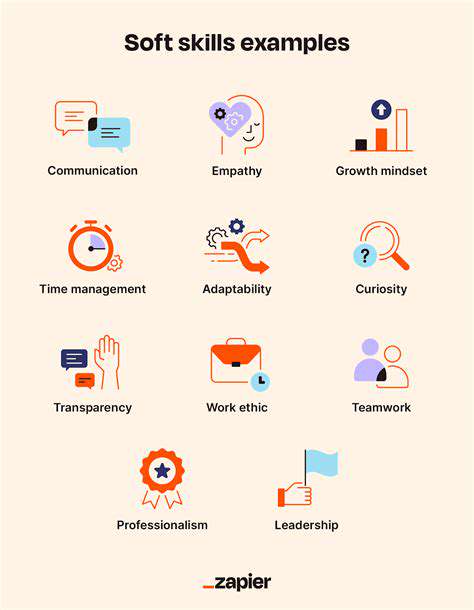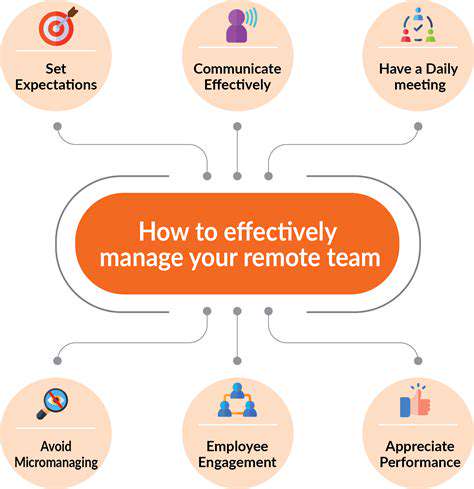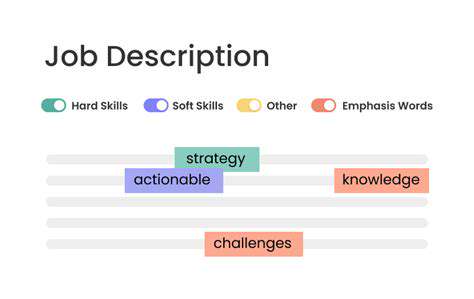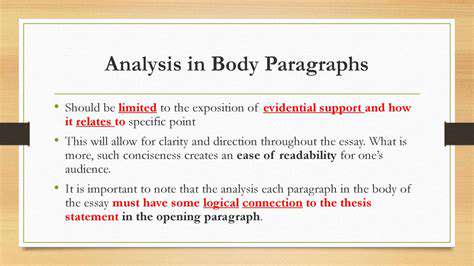How to Find Profitable Side Hustles
Understanding Your Skillset
Identifying your skills is the first crucial step in launching a successful side hustle. Think beyond your current job responsibilities; consider your hobbies, talents, and past experiences. Are you naturally organized? Do you excel at communication? Perhaps you're a whiz at graphic design or possess a knack for crafting compelling narratives. Recognizing these strengths, even seemingly minor ones, can unlock opportunities for income generation beyond your main employment.
Don't underestimate the value of transferable skills. A strong work ethic, developed in a previous role, can be invaluable in any entrepreneurial endeavor. Similarly, problem-solving skills honed in your daily life can be applied to create innovative solutions for your side hustle, ultimately leading to greater efficiency and profitability. Analyzing your skillset objectively is paramount for selecting a side hustle that aligns with your abilities and interests.
Exploring Your Passions
While skills are the tools, passions are the fuel that drives a profitable side hustle. What genuinely excites you? What activities do you find yourself naturally drawn to, even when you're not being paid to do them? These passions are the hidden motivators that will keep you engaged and inspired even when faced with challenges.
Connecting your skills with your passions is key. If you love crafting and have a knack for design, a side hustle selling handmade goods might be a perfect fit. If you're passionate about helping others and have strong communication skills, coaching or consulting could be a viable option. Understanding your passions can lead you to a side hustle that feels fulfilling and sustainable over time.
Market Research and Feasibility
Once you've identified your skills and passions, it's time to research the market. What are the current needs and demands that align with your skillset? Are there gaps in the market that you could potentially fill? Thorough market research will help you understand the competition, pricing strategies, and potential customer base for your proposed side hustle.
Consider the feasibility of your chosen venture. What resources do you need? What are the startup costs? How much time can you realistically dedicate to this side hustle without jeopardizing your primary employment or personal life? A realistic assessment of the feasibility of your idea will allow you to make informed decisions.
Defining Your Niche and Target Audience
Instead of trying to appeal to everyone, focus on a specific niche within your chosen field. This allows you to tailor your offerings to meet the specific needs of a target audience. For instance, if you're a writer, instead of focusing on general articles, you could specialize in writing for a particular industry or demographic. This targeted approach can help you stand out from the competition and attract a loyal customer base.
Knowing your target audience is crucial for crafting effective marketing strategies and tailoring your offerings to their specific needs. Understanding their preferences, pain points, and motivations will help you create a compelling value proposition that resonates with them.
Developing a Business Plan and Budget
A well-defined business plan is essential for any side hustle. Outline your goals, target audience, marketing strategies, pricing models, and financial projections. A clear plan will provide direction and help you stay focused on your objectives. This will also help you estimate the financial implications of your side hustle and how much you need to invest or budget for.
Creating a detailed budget is crucial for tracking expenses and ensuring profitability. Include costs like materials, marketing, tools, and potentially even workspace. By meticulously tracking your income and expenses, you can monitor your progress and make necessary adjustments to ensure your side hustle is financially sustainable.
Researching Market Demand and Trends: Pinpointing Opportunities
Understanding the Current Market Landscape
Thorough market research is crucial for identifying profitable opportunities. Analyzing current trends, including technological advancements, evolving consumer preferences, and economic shifts, provides valuable insights into emerging needs and potential gaps in the market. This understanding allows entrepreneurs to position their products or services to meet specific demands, fostering a greater likelihood of success.
Recognizing existing market saturation and identifying niche markets are also essential components. Are there areas where existing products or services fall short? Are there underserved demographics or geographic regions that could benefit from a new offering?
Analyzing Consumer Preferences and Behaviors
Consumer behavior is constantly in flux, and understanding the why behind purchasing decisions is vital for predicting future demand. This involves examining factors like demographics, lifestyles, and psychological influences on consumer choice. Market research methodologies such as surveys, focus groups, and social media analysis can provide valuable data for understanding consumer preferences and identifying trends.
By understanding the motivations and pain points of your target audience, you can effectively tailor your product or service to meet their needs and desires, ultimately leading to increased sales and profitability.
Identifying Potential Market Gaps
Market research should also involve identifying gaps or unmet needs in the existing market. This proactive approach allows businesses to develop solutions that address these gaps and create a unique selling proposition. Recognizing areas where competitors are lacking in their offerings can be a significant opportunity for innovation and market differentiation.
Careful consideration of competitor offerings, pricing strategies, and marketing approaches is essential when identifying potential gaps. Understanding what's missing or underserved in the marketplace can lead to the development of a product or service with a significant competitive edge.
Evaluating Market Size and Potential
Assessing the potential size and growth of a target market is essential for determining its profitability. Understanding the market share of competitors, projected growth rates, and overall market size can help evaluate the viability of an opportunity. A large and growing market presents a greater potential for profitability compared to a small and stagnant one.
Forecasting Future Trends and Projections
Analyzing industry trends and making predictions about future market demands is an integral part of successful market research. This involves understanding technological advancements, regulatory changes, and broader societal shifts that might affect the market and your business. Developing realistic projections based on reliable data helps entrepreneurs anticipate challenges and adjust strategies accordingly.
Staying informed about upcoming trends empowers businesses to anticipate shifts in consumer behavior and adapt their strategies proactively, maximizing their potential for success in the ever-changing market.
Competitive Analysis and Differentiation Strategies
A thorough understanding of your competitors is vital. Analyzing their strengths, weaknesses, pricing strategies, and marketing efforts allows you to identify potential areas for differentiation. This competitive analysis helps you to position your product or service uniquely within the market landscape, establishing a distinct value proposition.
Developing a competitive advantage through innovation, unique features, or superior customer service is crucial for attracting and retaining customers in a competitive market. By understanding the competitive landscape, you can avoid head-on competition and carve out a profitable niche for your business.

Crafting a Compelling Business Plan: Turning Ideas into Reality
Defining Your Business Vision
A compelling business plan starts with a clear vision. This isn't just about outlining what you want to sell; it's about articulating a compelling picture of your business's future. Consider what problem you aim to solve, what unique value proposition you offer, and how your business will impact the market. This vision statement should be inspiring and resonate with potential investors, employees, and customers alike. It should paint a vivid picture of the future success you envision, not just the immediate goals.
Thorough market research is crucial in developing a strong vision. Understanding your target audience, identifying competitors, and analyzing industry trends will help you tailor your business plan to the specific needs and desires of your customers. What are their pain points? How can you differentiate yourself from the competition? These are essential questions to address when shaping your business vision.
Analyzing Your Market and Competition
Understanding the landscape is paramount. Researching your target market is essential for crafting a successful business plan. Who are your ideal customers? What are their demographics, psychographics, and purchasing behaviors? In-depth analysis of your competitors is equally vital. What are their strengths and weaknesses? What are their pricing strategies? How can you position your business to offer something unique and valuable?
Identifying unmet needs and opportunities is key to building a viable business. Are there gaps in the market that your business can fill? What innovative solutions can you offer to address these gaps? This analysis allows you to strategically position your business to capture market share and thrive in a competitive environment. A robust understanding of the market and your competition will enable you to craft a compelling business plan that resonates with investors and customers alike.
Analyzing pricing strategies of competitors is a crucial step in positioning your business. Understanding their pricing models will help you determine a competitive yet profitable pricing strategy that aligns with your value proposition. Competitive analysis will help you avoid pricing yourself out of the market or undercutting your profitability.
Understanding the regulatory environment is also important. Are there any specific licenses, permits, or regulations you need to comply with? This proactive approach can save you significant headaches and financial losses down the line.
Developing a Realistic Financial Plan
A solid financial plan is the bedrock of any successful business. This isn't just about projections; it's about meticulous budgeting, accurate forecasting, and realistic cost estimations. How much capital will you need to start and operate? What are your projected revenue streams? What are your fixed and variable costs? A clear understanding of these elements is crucial for securing funding and maintaining financial stability.
Detailed financial projections are essential for demonstrating the viability of your business to potential investors. These projections should include detailed revenue forecasts, expense breakdowns, and profitability analysis. Having a realistic understanding of your financial position will allow you to identify potential challenges early on and adjust your strategies as needed to ensure long-term profitability and sustainability. This also helps you secure funding and attract investors.
Creating a comprehensive financial plan involves detailed cash flow projections, outlining expected inflows and outflows over a set period. This helps manage short-term liquidity needs and ensures your business can cover its expenses as they arise. Proper cash flow management is essential for long-term sustainability. By anticipating potential cash flow challenges, you can implement strategies to prevent financial distress.
Managing Time and Resources Effectively: Sustaining Your Side Hustle

Prioritizing Tasks
Effective time management hinges on prioritizing tasks based on their urgency and importance. Identifying critical tasks that directly contribute to key objectives is crucial for efficient resource allocation. This involves analyzing deadlines, dependencies, and potential roadblocks to prioritize actions that yield the greatest return on time invested. Neglecting this step often leads to wasted effort and missed deadlines.
A well-structured to-do list, incorporating a system for categorizing tasks by urgency and importance, is a valuable tool. This allows for a clear focus on high-priority items, ensuring that critical projects and deadlines are not overlooked. Proper prioritization saves both time and resources by preventing unnecessary rework and delays.
Efficient Scheduling and Planning
Scheduling and planning are cornerstones of effective time management. Developing a realistic schedule that allocates specific time slots for different tasks is essential for maintaining focus and avoiding multitasking. A well-defined schedule helps prevent procrastination and ensures consistent progress towards goals.
Regular review and adjustments to the schedule are vital for adapting to changing priorities and unexpected circumstances. Flexibility and adaptability are key to navigating the dynamic nature of work and personal life. This proactive approach minimizes disruptions and maximizes productivity.
Optimizing Resource Allocation
Strategic resource allocation is crucial for maximizing productivity and minimizing wasted effort. This includes assigning tasks to individuals with the appropriate skills and experience. This ensures that tasks are completed efficiently and effectively. Proper resource allocation also helps avoid bottlenecks and delays in project timelines.
Evaluating and adjusting resource allocation as needed is critical for adapting to changing project requirements. This proactive approach to resource management ensures projects stay on track and deliver desired outcomes within budget constraints. Flexible and adaptable resource allocation can significantly impact project success.
Delegation and Teamwork
Delegating tasks effectively is a cornerstone of successful project management and resource optimization. Identifying tasks suitable for delegation based on individual strengths and expertise is essential for maximizing team efficiency. This allows team members to focus on areas where they excel, leading to higher-quality output and faster project completion.
Time Tracking and Analysis
Monitoring time spent on different tasks provides valuable insights into work patterns and potential areas for improvement. Regular time tracking allows for a comprehensive analysis of productivity levels, identifying time-consuming activities, and inefficient workflows. This data-driven approach enables informed decisions for optimizing resource allocation and improving project timelines.
Analyzing time tracking data can reveal patterns in productivity and identify areas for improvement. Understanding where time is being spent allows for adjustments to improve efficiency and reduce wasted effort. This data-driven approach can lead to significant improvements in project management and resource optimization.
Minimizing Distractions
Creating a focused work environment is paramount for maximizing productivity. Identifying and minimizing distractions, such as notifications, interruptions, and clutter, is essential for maintaining concentration and preventing wasted time. A dedicated workspace, free from unnecessary stimuli, fosters a conducive environment for deep work.
Effective Communication and Collaboration
Effective communication and collaboration are key to coordinating efforts and avoiding misunderstandings. Clear communication channels and protocols for information sharing are essential for ensuring that everyone is on the same page and working towards the same objectives. Collaboration tools and platforms can facilitate seamless communication and information sharing across teams.
Read more about How to Find Profitable Side Hustles
Hot Recommendations
- How to Stay Productive While Working Remotely
- Tips for Managing Conflict with Coworkers
- Entrance & Certification Exams (升学考试)
- How to Improve Your Storytelling Skills (Speaking)
- How to Find Profitable Side Hustles
- Tips for Preparing for the TOEFL iBT Home Edition
- Guide to Switching Careers from [Industry A] to [Industry B]
- How to Run an Effective Hybrid Meeting
- Tips for Marketing Your Side Hustle on Instagram











![Best Online Courses for Learning [Specific Software, e.g., Excel]](/static/images/32/2025-07/AdvancedExcelCourses3ADataAnalysisandAutomation.jpg)